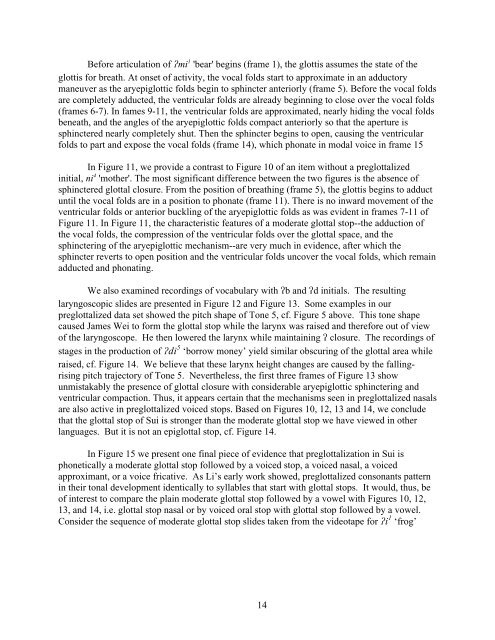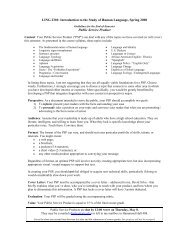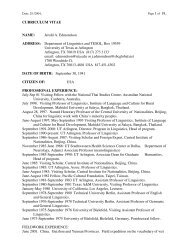1 A phonetic study of the Sui consonants and tones Jerold A ...
1 A phonetic study of the Sui consonants and tones Jerold A ...
1 A phonetic study of the Sui consonants and tones Jerold A ...
You also want an ePaper? Increase the reach of your titles
YUMPU automatically turns print PDFs into web optimized ePapers that Google loves.
Before articulation <strong>of</strong> �mi 1 'bear' begins (frame 1), <strong>the</strong> glottis assumes <strong>the</strong> state <strong>of</strong> <strong>the</strong><br />
glottis for breath. At onset <strong>of</strong> activity, <strong>the</strong> vocal folds start to approximate in an adductory<br />
maneuver as <strong>the</strong> aryepiglottic folds begin to sphincter anteriorly (frame 5). Before <strong>the</strong> vocal folds<br />
are completely adducted, <strong>the</strong> ventricular folds are already beginning to close over <strong>the</strong> vocal folds<br />
(frames 6-7). In fames 9-11, <strong>the</strong> ventricular folds are approximated, nearly hiding <strong>the</strong> vocal folds<br />
beneath, <strong>and</strong> <strong>the</strong> angles <strong>of</strong> <strong>the</strong> aryepiglottic folds compact anteriorly so that <strong>the</strong> aperture is<br />
sphinctered nearly completely shut. Then <strong>the</strong> sphincter begins to open, causing <strong>the</strong> ventricular<br />
folds to part <strong>and</strong> expose <strong>the</strong> vocal folds (frame 14), which phonate in modal voice in frame 15<br />
In Figure 11, we provide a contrast to Figure 10 <strong>of</strong> an item without a preglottalized<br />
initial, ni 4 'mo<strong>the</strong>r'. The most significant difference between <strong>the</strong> two figures is <strong>the</strong> absence <strong>of</strong><br />
sphinctered glottal closure. From <strong>the</strong> position <strong>of</strong> breathing (frame 5), <strong>the</strong> glottis begins to adduct<br />
until <strong>the</strong> vocal folds are in a position to phonate (frame 11). There is no inward movement <strong>of</strong> <strong>the</strong><br />
ventricular folds or anterior buckling <strong>of</strong> <strong>the</strong> aryepiglottic folds as was evident in frames 7-11 <strong>of</strong><br />
Figure 11. In Figure 11, <strong>the</strong> characteristic features <strong>of</strong> a moderate glottal stop--<strong>the</strong> adduction <strong>of</strong><br />
<strong>the</strong> vocal folds, <strong>the</strong> compression <strong>of</strong> <strong>the</strong> ventricular folds over <strong>the</strong> glottal space, <strong>and</strong> <strong>the</strong><br />
sphinctering <strong>of</strong> <strong>the</strong> aryepiglottic mechanism--are very much in evidence, after which <strong>the</strong><br />
sphincter reverts to open position <strong>and</strong> <strong>the</strong> ventricular folds uncover <strong>the</strong> vocal folds, which remain<br />
adducted <strong>and</strong> phonating.<br />
We also examined recordings <strong>of</strong> vocabulary with �b <strong>and</strong> �d initials. The resulting<br />
laryngoscopic slides are presented in Figure 12 <strong>and</strong> Figure 13. Some examples in our<br />
preglottalized data set showed <strong>the</strong> pitch shape <strong>of</strong> Tone 5, cf. Figure 5 above. This tone shape<br />
caused James Wei to form <strong>the</strong> glottal stop while <strong>the</strong> larynx was raised <strong>and</strong> <strong>the</strong>refore out <strong>of</strong> view<br />
<strong>of</strong> <strong>the</strong> laryngoscope. He <strong>the</strong>n lowered <strong>the</strong> larynx while maintaining � closure. The recordings <strong>of</strong><br />
stages in <strong>the</strong> production <strong>of</strong> �di 5 ‘borrow money’ yield similar obscuring <strong>of</strong> <strong>the</strong> glottal area while<br />
raised, cf. Figure 14. We believe that <strong>the</strong>se larynx height changes are caused by <strong>the</strong> fallingrising<br />
pitch trajectory <strong>of</strong> Tone 5. Never<strong>the</strong>less, <strong>the</strong> first three frames <strong>of</strong> Figure 13 show<br />
unmistakably <strong>the</strong> presence <strong>of</strong> glottal closure with considerable aryepiglottic sphinctering <strong>and</strong><br />
ventricular compaction. Thus, it appears certain that <strong>the</strong> mechanisms seen in preglottalized nasals<br />
are also active in preglottalized voiced stops. Based on Figures 10, 12, 13 <strong>and</strong> 14, we conclude<br />
that <strong>the</strong> glottal stop <strong>of</strong> <strong>Sui</strong> is stronger than <strong>the</strong> moderate glottal stop we have viewed in o<strong>the</strong>r<br />
languages. But it is not an epiglottal stop, cf. Figure 14.<br />
In Figure 15 we present one final piece <strong>of</strong> evidence that preglottalization in <strong>Sui</strong> is<br />
<strong>phonetic</strong>ally a moderate glottal stop followed by a voiced stop, a voiced nasal, a voiced<br />
approximant, or a voice fricative. As Li’s early work showed, preglottalized <strong>consonants</strong> pattern<br />
in <strong>the</strong>ir tonal development identically to syllables that start with glottal stops. It would, thus, be<br />
<strong>of</strong> interest to compare <strong>the</strong> plain moderate glottal stop followed by a vowel with Figures 10, 12,<br />
13, <strong>and</strong> 14, i.e. glottal stop nasal or by voiced oral stop with glottal stop followed by a vowel.<br />
Consider <strong>the</strong> sequence <strong>of</strong> moderate glottal stop slides taken from <strong>the</strong> videotape for �i 1 ‘frog’<br />
14





